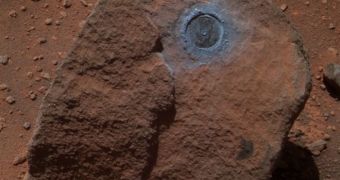While Spirit is stuck inside a patch of loose sand called Troy, on the other side of Mars, Opportunity is continuing to conduct relevant science at its current location. For more than two months, it has been studying a piece of rock called the Marquette Island, which is apparently one of the most interesting ones the team managing the robot has ever come across. No larger than a basketball, the rock has thus far yielded many of its secretes to the prying eyes and robotic arm of the rover, but now experts are saying that the robot has moved on, heading for its primary target, the Endeavor crater.
Researchers believe that one of the main things separating the “Island” from any other space rocks discovered by Opportunity (save for one) is the fact that it might have originated deep within Mars' crust, which makes it of particular interest. “Marquette Island is different in composition and character from any known rock on Mars or meteorite from Mars. It is one of the coolest things Opportunity has found in a very long time,” the principal investigator of the Mars Exploration Rovers (MER) mission, Steve Squyres, explains. He is based at the Cornell University, in Ithaca, New York.
According to available data on Marquette Island, it most likely formed out of cooling molten rock. This becomes obvious when looking at the structure's surface, which is coarse-grained. Extensive analyses have confirmed that the entire body is made of basaltic rock, which means that the Island was formed somewhere else, and then ejected to its current location, where it had time to cool. “It is from deep in the crust and someplace far away on Mars, though exactly how deep and how far we can’t yet estimate,” Squyres adds, quoted by Space Fellowship.
Opportunity also used its rock-abrasion tool on the rock, in order to allow researchers to get a good look inside, where the stone was not in decay. The instrument used for this investigation is placed on the tip of the rover's robotic arm, and is designed and built by the New York-based Honeybee Robotics Spacecraft Mechanisms Corp. “We took a conservative approach on our target depth for this grind to ensure we will have enough of the bit left to grind the next hard rock that Opportunity comes across,” Joanna Cohen, a representative of the company, says. The rock-abrasion tool was initially designed to investigate a single rock, but Opportunity has been at it for six straight years.
At this point, as experts continue to analyze the wealth of data beamed back by the rover, the actual robot has left Marquette Island, on January 12, and is currently moving away towards the Endeavor Crater. “We’re on the road again. The year ahead will include lots more driving, if all goes well. We’ll keep pushing for Endeavor crater but watch for interesting targets along the way where we can stop and smell the roses,” rover mission manager Mike Seibert, from the NASA Jet Propulsion Laboratory (JPL), in Pasadena, California, says. The robot drove for more than 3.3 miles in 2009, which is the farthest it ever did in a single year.

 14 DAY TRIAL //
14 DAY TRIAL //